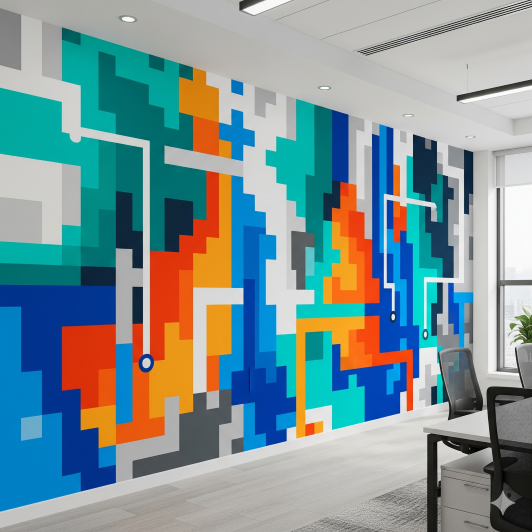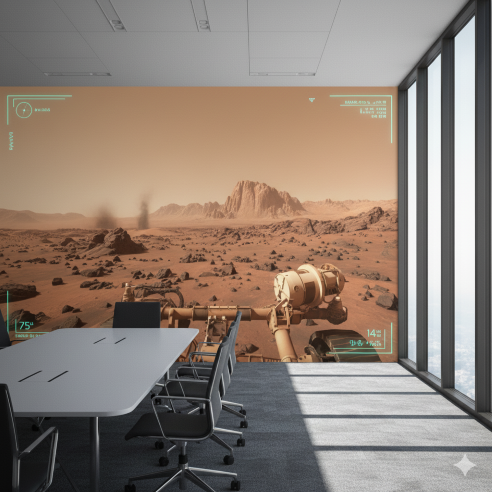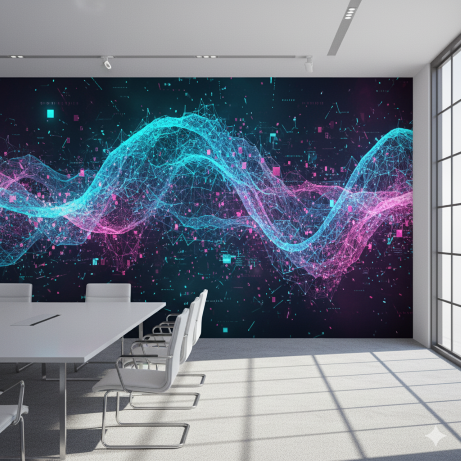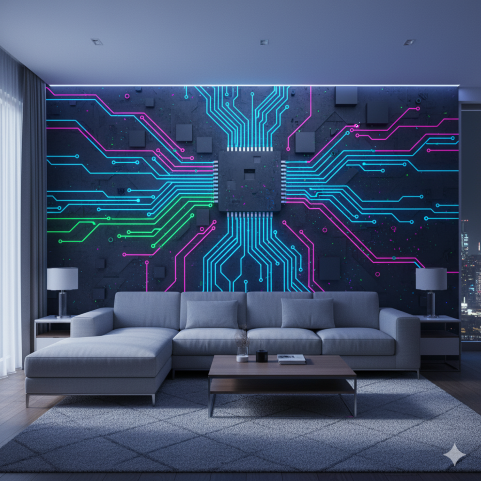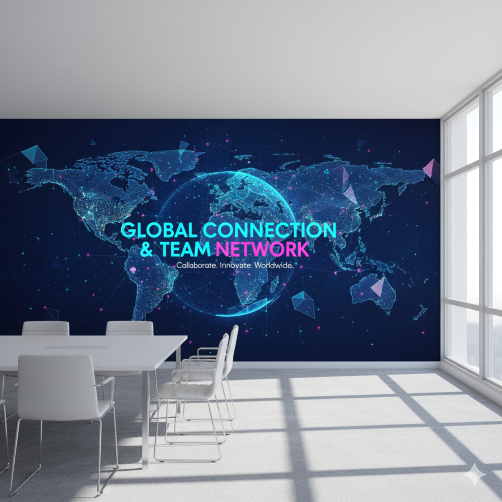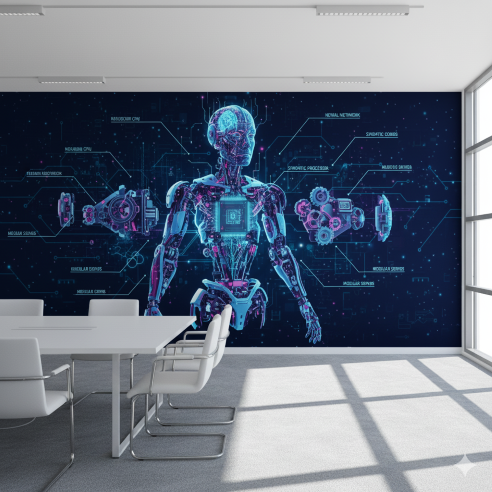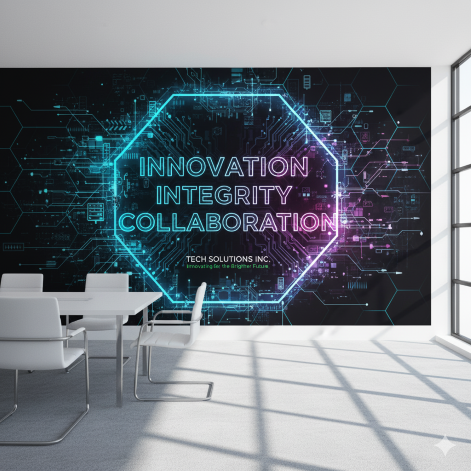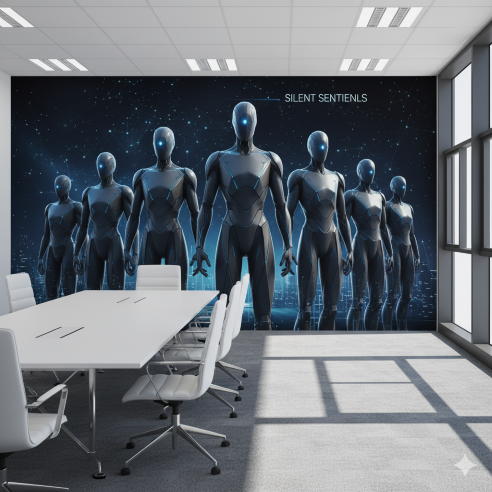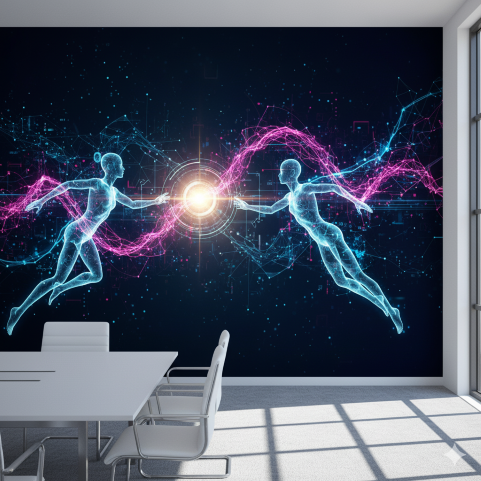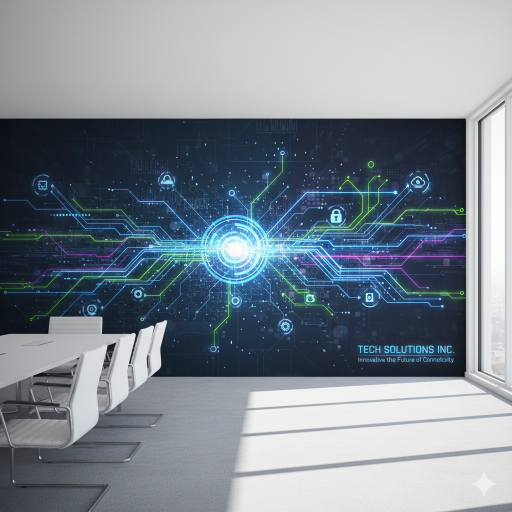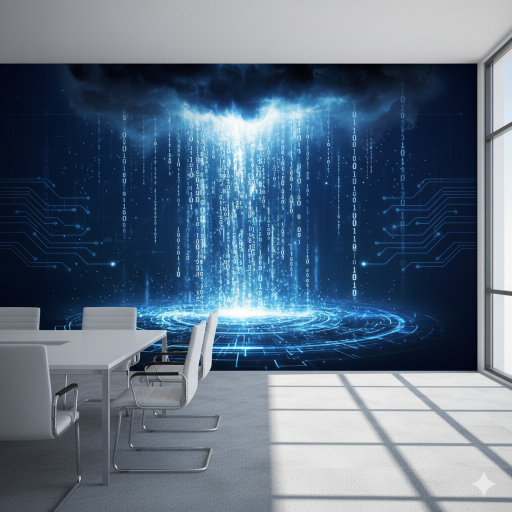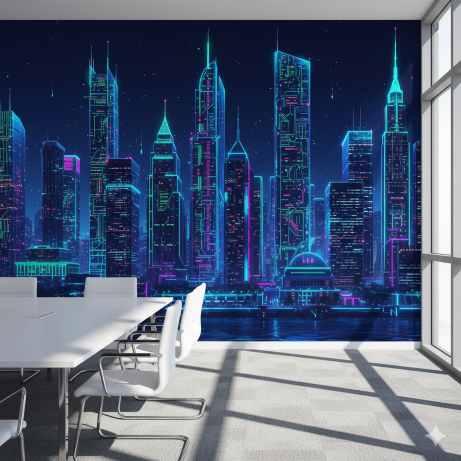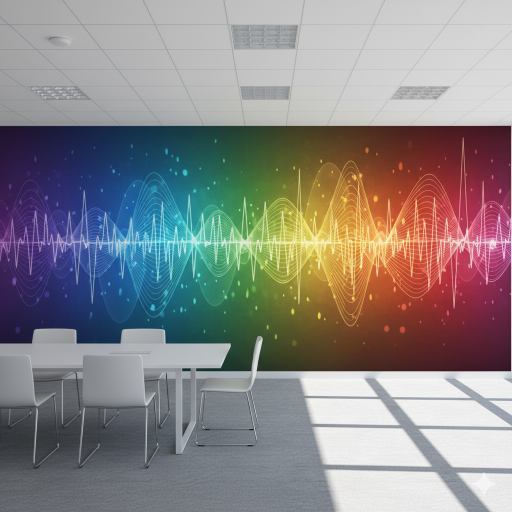Description
Categories in Information Technology Wall Art
(IT) Information Technology wall art is a fantastic way to personalize a workspace, whether it’s a corporate tech office, a developer’s home office, or a high-tech gaming room. The aesthetic generally falls into a few distinct, visually appealing categories that celebrate the complexity, history, and future of computing and data.
1. Circuitry and Hardware Focus Information Technology Wall Art
This is perhaps the most iconic IT visual, celebrating the physical foundation of technology.
Circuit Board Visuals
This highly recognizable IT visual aesthetic transforms the complex architecture of a Printed Circuit Board (PCB) into modern art. Murals and prints employ extreme close-ups or stylized, simplified schematics, focusing on the labyrinthine network of copper traces and connection points. The visual drama is achieved through high-contrast lighting and color. And it frequently features electric blue or neon green lines that appear to glow against a deep black or metallic background. This style instantly conveys a sense of speed, complexity, and interconnectedness. This makes it a perfect, dynamic centerpiece for tech offices, networking rooms, or contemporary workspaces that celebrate the digital infrastructure.
Hardware Blueprints/Patents
The Hardware Blueprints/Patents style offers a sophisticated nod to the rich history of computing and engineering. Art is derived from the official, precise drawings used to file patents for foundational technology. The pieces typically feature white or fine lines on a contrasting, aged background. Like a blueprint, blue or vintage parchment tone. Popular subjects include the mechanical components of the first programmable computers (ENIAC), early peripherals, or iconic relics like the floppy disk. This aesthetic appeals to a desire for nostalgia and intellectual appreciation. But offers a subtle, refined, and educational tribute to the inventors who paved the way for modern IT.
CPU/Chip Art
Focusing on the core of processing power, CPU, and Microchip art emphasizes the incredible density and sophistication of modern hardware. This visual typically uses macro photography to reveal the minuscule, grid-like geometric patterns. And etched lines on a processor’s surface, often highlighting the reflective, metallic finish. Alternatively, the design might use abstract, stylized representations of integrated circuits to convey immense, concentrated power. It is an aesthetic that symbolizes efficiency, advanced engineering, and the sheer volume of data processing occurring on a microscopic scale. This art serves as a powerful, intellectual focal point in any room dedicated to advanced technology.
2. Data, Code, and Abstraction
This category focuses on the invisible language and flow of information that powers IT.
Binary Code
This aesthetic distills technology down to its most fundamental language. The binary stream of zeros and ones. Imagery often features stark, high-contrast compositions where these digits cascade down the wall, reminiscent of the classic Matrix digital rain. The style is inherently minimalist and iconic, immediately signaling computing heritage. It can range from clean, monochrome representations suitable for a serious programming environment to more vibrant, glowing iterations that feel dynamic and energetic. This visual choice directly honors the logic gates and machine language that underpin all modern software. Offering a direct and powerful statement piece.
Abstract Data Streams
Moving beyond literal code, this style visualizes the invisible architecture of data flow. Murals in this category use dynamic, flowing compositions. Think glowing fiber optic light trails, complex volumetric meshes, or energetic digital particle clouds. The palette is usually highly saturated, featuring electric blues, deep magentas, and vibrant cyan neons, set against dark voids to maximize the sense of motion and energy. It serves as a perfect artistic interpretation of abstract concepts. Like Big Data analysis, machine learning processes, or high-speed data transfer, making the invisible tangible and visually exciting.
Network Maps
3. Futuristic & AI Concepts
Art that looks toward the cutting edge of IT and science fiction.
Artificial Intelligence (AI) Brains
This aesthetic is a profound visual metaphor for the rise of machine intelligence. Art in this category typically portrays the human brain using abstract digital elements. For example, interconnected nodes, pulsing light patterns, or interwoven circuits. The intention is to symbolize the conceptual breakthrough of neural networks and deep learning. The palette often features luminous, ethereal colors like cool blues, vibrant pinks, or gold against a dark, cosmic background, evoking a sense of powerful, emerging consciousness. This style is popular for spaces dedicated to R&D, data science, and innovation, representing the cutting edge of cognitive technology.
Robotics and Cybernetics
This sub-category explores the physical manifestation of technology, focusing on the interface between human and machine. Artwork often showcases detailed bionic limbs, sophisticated robotic mechanisms, or close-ups of digital eyes, emphasizing precision and futuristic design. The mood can be utilitarian and stark, using polished metal textures and exposed wiring. Or sleek and minimalist, favoring seamless synthetic materials. This art appeals to those fascinated by automation, advanced manufacturing, and the philosophical implications of augmented humanity, serving as a bold statement about the future of physical technology and engineering.
Sci-Fi Tech
Drawing inspiration from classic and modern science fiction, this art transports viewers to imagined digital worlds. Prints commonly feature detailed renderings of futuristic user interfaces (UIs) or Heads-Up Displays (HUDs), sleek spacecraft navigating digital cityscapes, or iconic fictional gadgets. This aesthetic is characterized by its use of layered graphics, geometric overlays, and highly detailed, illuminated control panels. It’s designed to tap into a sense of nostalgia and limitless possibility, providing a fun, imaginative, and inspirational backdrop that celebrates the role of science fiction in shaping real-world technological ambitions.
4. Humor and Definition Art (For Offices/Breakrooms)
These pieces use text and typography to inject personality and humor relevant to IT professionals.
Definition Posters
Definition posters use the formal presentation of dictionary entries to deliver witty, relatable, or satirical commentary on the Information Technology field. These prints typically feature a bold term (like “IT Guy,” “Database,” or “Bug”) followed by a definition written with an insider’s perspective. The humor often stems from highlighting the gap between official expectations and the messy reality of the job, such as defining “Support Ticket” based on its triviality. This style is highly effective in breakrooms, hallways, or non-client-facing areas where staff appreciate the shared language and camaraderie, boosting morale through shared, self-aware humor.
Motivational/Humorous Quotes
This art category leverages typography and iconic tech phrases to create engaging, lighthearted information technology wall decor. Pieces often feature instantly recognizable snippets like error codes, programming commands (e.g., Ctrl+Alt+Del, git commit), or binary sequences presented in a clever or stylized font. The quotes often center on the struggles of coding, debugging, or dealing with common user issues, like a dramatic warning about not turning off a computer. This style serves as a quick, funny source of in-the-moment motivation and reinforces a relaxed, relatable company culture, turning everyday technical jargon into fun, graphic statements.
Information Technology Wall Art Design Considerations
| Element | Description | Common Applications |
| Color Palette | Dominated by dark backgrounds (black, navy, charcoal) to make glowing elements pop, contrasted with electric blues, greens, neon colors, or metallic accents (gold, silver, copper). | Circuitry, Data Streams, AI Art |
| Texture/Medium | Canvas prints are popular for a gallery feel. Vinyl decals are great for large wall areas or geometric shapes. Laser-etched wood can offer a warm, tactile version of patent art. | Decals for large murals; Prints for detail work. |
| Style Application | Minimalist designs using simple lines work well in modern offices, while photorealistic prints of chips or historical tech suits dedicated tech labs. | Abstract/Geometric styles suit contemporary spaces. |
Information technology wall art serves not just as decoration, but as a visual language that communicates passion, technical depth, and a forward-thinking mindset.

